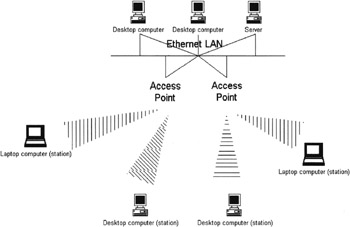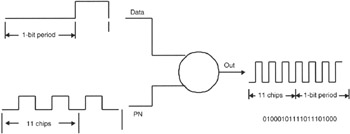Chapter 2: How Does 802.11 Work?
|
|
What, technically speaking, is 802.11b and how does it relate to IEEE 802.11? This chapter covers the technology of transmitting data over the airwaves, the process of that transmission, and the topologies and components of wireless networks. Thousands of enterprises worldwide are cutting the wires to their local area networks (LANs) to enjoy greater productivity from their unwired work force. 802.11b also has the potential to save money on infrastructure (wiring buildings for networks) and telecommunications services.
How Does Wireless Fidelity (Wi-Fi) Work?
A networked desktop computer is connected to a larger network (a LAN, wide area network [WAN], or the Internet) via a network cable to a hub, router, or switch. The computer's network interface card (NIC) sends zeros and ones down the cable by changing the voltage on the wires from +5 volts to -5 volts in a prearranged cadence. Wi-Fi simply replaces these cables with small, low-powered two-way radios. Instead of changing the voltage on a wire, it encodes the zeros and ones by laying an alternating radio signal over a constant existing signal in a prearranged cadence. The alternating signal encodes zeros and ones on the radio waves. The 802.11b specification allows for the wireless transmission of approximately 11 Mbps of raw data at distances up to a few hundred feet over the 2.4 GHz unlicensed band. The distance depends on impediments, materials, and line of sight.
Many people might ask, "So what?" It means a PC user can install a $70 PC card in his or her laptop or personal digital assistant (PDA) and be connected to the Internet or corporate network as if he or she was still tied to a desk. Enterprises have been quick to adopt this technology based on the following factors:
-
Wiring a building for voice and data is expensive.
-
It improves worker productivity by allowing mobility within a building or corporate campus.
-
It does not require right-of-way agreements to bring service to a business.
-
It is independent of distance limitation to the central office.
-
It is relatively free of federal, state, and local regulations.
A wireless local area network (WLAN) installation usually uses one or more access points (APs), which are dedicated stand-alone hardware with typically more powerful antennas. Figure 2-1 illustrates a WLAN. In addition to servicing enterprise networks, 802.11b has become the most popular standard for public short-range networks, known as hot spots, found at airports, hotels, conference centers, and coffee shops and restaurants. Several companies currently offer paid hourly, session-based, or unlimited monthly access via their deployed networks around the United States and internationally.[1]

Figure 2-1: A WLAN on an enterprise network
How Is Data Transmitted via Wireless Technology?
The 802.11 standard provides for two radio frequency (RF) variations (as opposed to infrared) of the physical (PHY) layer. These include direct sequence spread spectrum (DSSS) and frequency-hopping spread spectrum (FHSS). Both of these were designed to comply with the Federal Communications Commission (FCC) regulations (FCC 15.247) for operation in the 2.4 GHz band, which is an unlicensed spectrum. 802.11b uses DSSS.
DSSS systems use technology similar to Global Positioning System (GPS) satellites and some types of cell phones. Each information bit is combined with a longer pseudorandom numerical (PN) in the transmission process. The result is a high-speed digital stream, which is then modulated onto a carrier frequency using differential phase-shift keying (DPSK). Figure 2-2 illustrates how data is modulated with a PN sequence for wireless transmission.[2]

Figure 2-2: Digital modulation of data with PN sequence
As illustrated in Figure 2-2, DSSS works by taking a data stream of zeros and ones and modulating it with a second pattern-the chipping sequence. The sequence is also known as the Barker code, which is an 11-bit sequence (10110111000). The chipping or spreading code is used to generate a redundant bit pattern to be transmitted, and the resulting signal appears as wideband noise to the unintended receiver. One of the advantages of using spreading codes is that even if one or more of the bits in the chip are lost during transmission, statistical techniques embedded in the radio can recover the original data without the need for retransmission. The ratio between the data and width of spreading code is called processing gain. It is 16 times the width of the spreading code and increases the number of possible patterns to 64,000 (216), reducing the chances of cracking the transmission.
The DSSS signaling technique divides the 2.4 GHz band into fourteen 22 MHz channels, of which 11 adjacent channels overlap partially and the remaining 3 do not overlap. Data is sent across one of these 22 MHz channels without hopping to other channels, causing noise on the given channel. To reduce the number of retransmissions and noise, chipping is used to convert each bit of user data into a series of redundant bit patterns called chips. The inherent redundancy of each chip, combined with spreading the signal across the 22 MHz channel, provides the error checking and correction functionality to recover the data. Spread spectrum products are often interoperable because many are based on the IEEE 802.11 standard for wireless networks. DSSS is used primarily in interbuilding LANs, as its properties are fast and far reaching.[3]
At the receiver, a matched filter correlator is used to remove the PN sequence and recover the original data stream. At a data rate of 11 Mbps, DSSS receivers use different PN codes and a bank of correlators to recover the transmitted data stream. The high-rate modulation method is called complimentary code keying (CCK).
As illustrated in Figure 2-2 the PN sequence spreads the transmitted bandwidth of the resulting signal (hence the term spread spectrum) and reduces peak power. The total power remains unchanged. Upon receipt, the signal is correlated with the same PN sequence to reject narrowband interference and recover the original binary data. Regardless of whether the data rate is 1, 2, 5.5, or 11 Mbps, the channel bandwidth is about 20 MHz for DSSS systems.

Figure 2-3: The spreading of spectrum for transmission in DSSS or FHSS
The Significance of Spread Spectrum Radio
One of the basic technologies underlying the IEEE 802.11 series of standards is spread spectrum radio. The fundamental concept of spread spectrum radio is the use of a wider frequency bandwidth than that needed by the information that is transmitted. Using extra bandwidth would seem to be wasteful, but it actually results in several benefits, including reduced vulnerability to jamming, less susceptibility to interference, and coexistence with narrowband transmissions. Several spread spectrum techniques are available, including time hopping, frequency modulation, FHSS, DSSS, and hybrids of these.
FHSS and DSSS are not modulation techniques, but methods of distributing a radio signal across bandwidth. In addition to spreading the signal across a frequency band, spread spectrum systems modulate the signal. Modulation is the variation of a radio signal to convey information. The base signal is called the carrier. The variation may be based on the strength (amplitude modulation [AM]), frequency, or phase (frequency offset) of the signal. The modulation technique directly affects the data rate. Higher data rate modulations are generally more complex and expensive to implement. Modulations resulting in higher data rates pack more information in the same bandwidth. Small disruptions in the signal cause the degradation of more data. This means that the signal must have a higher signal-to-noise ratio (SNR) at the receiver to be effectively processed. Because a radio signal is stronger the closer it is to the source, the SNR decreases with distance. This is why higher-speed systems have less range. Examples of modulation techniques used in the IEEE 802.11 series of specifications include binary phase-shift keying (BPSK), quadrature phase-shift keying (QPSK), Gaussian frequency-shift keying (GFSK), and CCK.
[1]"OK, What Is Wi-Fi?" a white paper from Wi-Fi Consulting, www.wificonsulting.com/Wi-Fi101/wifi101.htm.
[2]Jim Zyren and Al Petrick, "IEEE 802.11 Tutorial," a white paper from Wireless Ethernet, www.wirelessethernet.org/downloads/IEEE_80211_Primer.pdf.
[3]Plamen Nedeltchev, "WLANs and the 802.11 Standard," a white paper from Cisco Systems, www.cisco.com/warp/public/784/packet/jul01/pdfs/whitepaper.pdf
|
|
EAN: 2147483647
Pages: 96